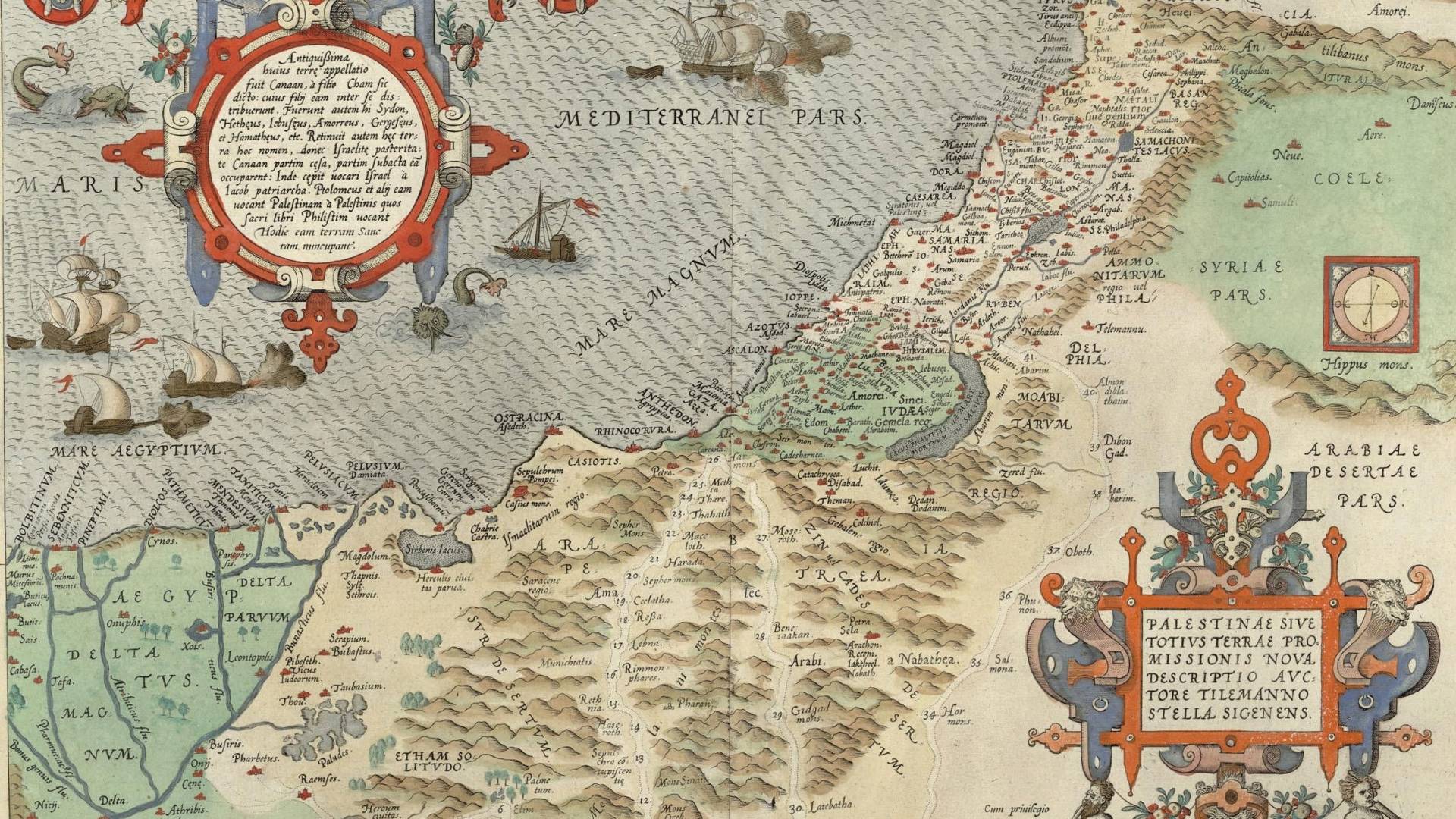

Deacon-structing Church Mothers, part 6
Deacon Pedro
Monday, July 26, 2021

A 16th-century map of Palestine and the surrounding region. From the collection of the National Library of Israel, courtesy of the Eran Laor Cartographic Collection.
Over the last five weeks, I’ve been taking a little bit of liberty in referring to some early women saints as “Church Mothers”. You may remember that we call Church Fathers those men in the early Church who contributed to defining Church doctrine. Some of them are also considered Doctors of the Church. But we don’t have “Mothers of the Church”. Still, the early Church had many influential women who worked with and influenced our Church Fathers and who, in their own right, greatly contributed to the practice of the Faith.
First, we learned about Thecla, Irene of Macedonia, Macrina the Elder, Macrina the Younger, Nino, and Proba. Four weeks ago, we learned about the daughters of St. Philip the Deacon. Then we learned about Eudokia, Blandina, Syncletica, Demiana, and Margaret the Virgin. Two weeks ago, we learned about Marcella, Monica, Helena, Catherine of Alexandria, and Mary of Egypt, and last week, we learned about Melania the Elder and her granddaughter, Melania the younger, and about St. Paula and her daughter Eustochium.
Today I’d like to conclude our series with a woman who has been called the first pilgrim to the Holy Land.
Egeria (also written Etheria or Aetheria) was a Galician woman from Hispania (present-day Spain), who travelled to Jerusalem in the late 4th century and kept a detailed journal of her travels. She describes all the sights and her experiences, and at the end, she describes many of the liturgies that she experienced while in the Holy Land. It is the earliest account of any such travel that exists to this date.
Egeria details her travels in a letter, now called the Itinerarium Egeriae or Peregrinatio Aetheriae, addressed to her “sisters” at home. For this reason, some have concluded that she was a nun. However, given the fact that she was able to make such a journey during this time in history, lasting a total of three years, it is likely that she was a woman of nobility and wealth.
In the first part of her letter, Egeria describes her travels while she spent three years with Jerusalem as her home base. Among the places she writes about are Old Testament sites like Rameses, the tomb of Job, Rachel’s Well, the city of Melchizedek, the Red Sea, and Mounts Sinai, Horeb, and Nebo. She also writes about some sites we would visit nowadays like the Jordan Valley, the Sea of Galilee, Capernaum, Nazareth, and the Mount of Beatitudes. Finally, on her return home, she travelled north to Antioch and to Edessa, crossing the Euphrates into Mesopotamia and Syria before heading back to Constantinople via Tarsus.
Wherever Egeria went, she was greeted, welcomed, and accompanied by local monks, priests, and bishops as if she were a celebrity. Sometimes, depending on how dangerous her destination, she even had a military escort. She describes each site in much detail. For example, arriving at Sinai, she says that the valley under the mountain was 16 miles in length. Most interestingly, she participates in all the proper rituals for each place, and she includes with her descriptions of each site the proper biblical reference and sometimes even some commentary or explanation.
At the site of the Burning Bush she writes:
 Every week, Deacon Pedro takes a particular topic apart, not so much to explore or explain the subject to its fullness, but rather to provide insights that will deepen our understanding of the subject. And don’t worry, at the end of the day he always puts the pieces back together. There are no limits to deaconstructing: Write to him and ask any questions about the faith or Church teaching: [email protected]. Follow him on Facebook, Twitter and Instagram.
Every week, Deacon Pedro takes a particular topic apart, not so much to explore or explain the subject to its fullness, but rather to provide insights that will deepen our understanding of the subject. And don’t worry, at the end of the day he always puts the pieces back together. There are no limits to deaconstructing: Write to him and ask any questions about the faith or Church teaching: [email protected]. Follow him on Facebook, Twitter and Instagram.
“Now it was about the tenth hour when we had arrived at the place, and so, as it was late, we could not make the oblation, but prayer was made in the church and also at the bush in the garden, and the passage from the book of Moses was read according to custom. Then, as it was late, we took a meal with the holy men at a place in the garden before the bush; we stayed there also, and next day, rising very early, we asked the priests that the oblation should be made there, which was done.”The second part of Egeria’s letter details various liturgical ceremonies and practices that she experienced while in Jerusalem. This was at a time when our liturgical practices were not yet universalized; at this time, for example, December 25th was not universally accepted as the date of the Feast of the Nativity! Still, Egeria describes in much detail the daily offices, matins, vespers, the Sunday celebrations, the Feasts of Epiphany and the Presentation, and Lent and Holy Week, as well as the season of Easter. She writes that on Good Friday, after keeping vigil the whole night, the Passion was read, then everyone went to pray at the column where they believed the Lord was scourged. This is followed by a veneration of the Cross. The deacons stood on guard because, “the custom is that the people, both faithful and catechumens, come one by one and, bowing down at the table, kiss the sacred wood and pass through. And because, I know not when, someone is said to have bitten off and stolen a portion of the sacred wood, it is thus guarded by the deacons who stand around, lest anyone approaching should venture to do so again.” After describing the Easter time celebrations, concluding with Pentecost, she goes on to describe the preparation of the catechumens for baptism. She often makes reference to how things were done at home or "as is the custom" in other places. For example, she details that just as at home they keep forty days (Quadragesima) before Easter, in Jerusalem they keep eight weeks, explaining that there is never fasting on any “Sabbath” throughout the year, fasting being eating only once a day. On her return back to Spain, Egeria stopped in present-day Turkey to visit the Shrine of St. Thecla, to whom it's clear she had a devotion. She writes:
“When I had arrived in the Name of God, prayer was made at the memorial, and the whole of the acts of saint Thecla having been read, I gave endless thanks to Christ our God, who deigned to fulfill my desires in all things, unworthy and undeserving as I am. Then, after a stay of two days, when I had seen the holy monks and apotactitae who were there, both men and women, and when I had prayed and made my communion, I returned to Tarsus and to my journey.”After this, she writes of her express desire to travel to Ephesus “because of the memorial of the holy and blessed Apostle John”. This is where her diary ends. Towards the end she makes reference to feeling tired, perhaps sick, but not eager to return to Spain. It is not clear how or when she died or whether she was able to return to Galicia. I like to imagine that perhaps Egeria, as she made her way home, came across Melania the Younger or her grandmother – perhaps she met St. Paula and Eustochium in Bethlehem. Maybe she met St. Marcella, and together they rejoiced at the wonderful opportunities our Lord had given them to participate in spreading the Good News. We have one of the earliest accounts of the liturgy thanks to one of our Greek Fathers, St. Justin Martyr, who wrote about it around AD 155 in his First Apology. It is amazing to see how the essence of the Mass has not changed much since. Reading Egeria’s diary also connects us to those early Christian practices and makes us realize that when we visit holy sites and when we participate in liturgy, we are closer to our early Christian Fathers and Mothers than we think. If you liked learning about these great early Church women, you may want to also look up St. Pelagia, St. Domnina of Syria, and St. Mary of Edessa.
 Every week, Deacon Pedro takes a particular topic apart, not so much to explore or explain the subject to its fullness, but rather to provide insights that will deepen our understanding of the subject. And don’t worry, at the end of the day he always puts the pieces back together. There are no limits to deaconstructing: Write to him and ask any questions about the faith or Church teaching: [email protected]. Follow him on Facebook, Twitter and Instagram.
Every week, Deacon Pedro takes a particular topic apart, not so much to explore or explain the subject to its fullness, but rather to provide insights that will deepen our understanding of the subject. And don’t worry, at the end of the day he always puts the pieces back together. There are no limits to deaconstructing: Write to him and ask any questions about the faith or Church teaching: [email protected]. Follow him on Facebook, Twitter and Instagram.Related Articles:
<<













